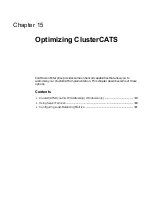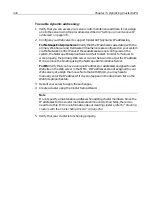
340
Chapter 15 Optimizing ClusterCATS
Using Server Failover
The ability to fail over servers that have become unavailable to redundant servers is a
cornerstone of any mission-critical application, one that ensures an application’s
continuous and reliable operation. Server failover was an option to select during the
installation process. If you did not select it during installation, you must reinstall
ClusterCATS and select that option.
Static versus ClusterCATS dynamic IP addressing
There are two schemes with which you implement server failover:
•
Static IP addressing.
Under static IP addressing, when a machine fails, the IP
address(es) that is bound to its Web server is reassigned to the most available
cluster member’s Web server. When the failed over server comes back online, it
must claim the IP address and then reboot again.
•
Dynamic IP addressing.
ClusterCATS can be configured to dynamically assign IP
addresses so that when a server fails, it’s IP address(es) can be assigned to other
servers. When the failed over server comes back online, ClusterCATS returns the
IP addresses to it without conflict.
On Windows clusters, Allaire recommends that you use server failover with the
ClusterCATS dynamic IP address scheme. In order to configure ClusterCATS dynamic
IP addresses, the IP address associated with the computer name must be different
from the IP addresses associated with the Web sites. ClusterCATS refers to the IP
address associated with the computer name as the maintenance address. For more
information on setting up your Web site with the ClusterCATS dynamic IP addressing
scheme, refer to
“ClusterCATS Dynamic IP Addressing (Windows only)” on page 334
.
Windows domain controllers
If you are using Windows NT Domain server authentication, then each web server in
a cluster must participate as a member NT Server in a domain. Do not make any
server in your cluster the Primary Domain Controller (PDC). Server Fail-Over will
interfere with the function of the PDC. One of the NT servers can be a Backup
Domain Controller but it is not the recommended configuration.
Summary of Contents for COLDFUSION 5-ADVANCED ADMINISTRATION
Page 1: ...Macromedia Incorporated Advanced ColdFusion Administration ColdFusion 5...
Page 20: ......
Page 56: ...38 Chapter 1 Advanced Data Source Management...
Page 74: ...56 Chapter 2 Administrator Tools...
Page 76: ......
Page 86: ...68 Chapter 3 ColdFusion Security...
Page 87: ...To Learn More About Security 69...
Page 88: ...70 Chapter 3 ColdFusion Security...
Page 130: ...112 Chapter 5 Configuring Advanced Security...
Page 132: ......
Page 154: ...136 Chapter 6 Configuring Verity K2 Server...
Page 162: ...144 Chapter 7 Indexing XML Documents...
Page 202: ...184 Chapter 8 Verity Spider...
Page 236: ...218 Chapter 10 Verity Troubleshooting Utilities...
Page 238: ......
Page 348: ...330 Chapter 14 ClusterCATS Utilities...
Page 349: ...Using sniff 331...
Page 350: ...332 Chapter 14 ClusterCATS Utilities...
Page 362: ...344 Chapter 15 Optimizing ClusterCATS...
Page 372: ...354 Index...















































